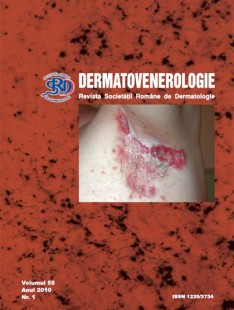Clinical cases
Granuloma faciale: observations on a case
Introduction:
Granuloma faciale is an uncommon dermatosis characterized by single or multiple sharply demarcated, asymptomatic, red-purple or brown plaques or nodules, usually occurring over the face, but occasionally extrafacial involvement was noted. Some histological characteristics as presence of eosinophil granulocytes facilitate the diagnosis of granuloma faciale.
Clinical case:
A 59-year-old male patient presented with two well demarcated, asymptomatic, reddish-brown plaques, with a smooth surface with prominent follicular orifices, 2,5 cm and respectively 1,5 cm in diameter, on his face. Histopathological examination showed polymorphous inflammatory infiltrate located in the papillary and reticular dermis comprising of neutrophils, eosinophils, hystiocytes, lymphocytes and plasmocytes, predominantly with perivascular pattern, sparing the epidermis and periappendageal areas, but the capillaries were affected.
Clinical and histopathological examinations have been sustained diagnosis of granuloma faciale. The patient was treated with intralesional betamethasone followed by almost complete resolution of lesions.
Discussion:
The etiology of granuloma faciale remains unknown. It has been suggested that actinic exposure may play an important role or this may be a form of vasculitis mediated by circulating immune complexes due to a localized Arthus-like response. There are not an efficient and specific medication of granuloma faciale, therefore, many different medical ans surgical therapies have been tried.
Conclusion:
Location on the face and chronic relapsing course after various therapies make granuloma faciale a problem of treatment.


